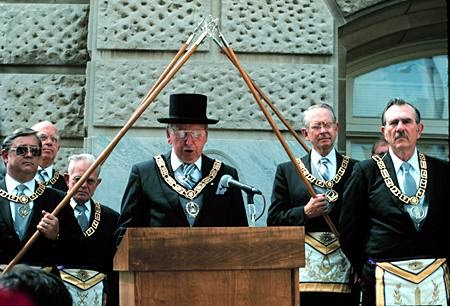We explore in this blog the history behind the cornerstone, a symbol initiates first learn about in the Entered Apprentice Degree and central to one of the fraternity’s best-known public ceremonies.

In contrast to the sacrifices and superstitions of ancient times, Freemasons in their ceremonies have made the cornerstone a symbol of the individual Mason and the sacrifices of labor and time necessary to build a moral and Masonic edifice. Today we hollow out the cornerstones, placing small objects inside, like coins, photographs, newspapers, or a list of those who erected the building; it’s wholly up to the committee in charge’s imagination. This tradition includes a subtle nod to its origin; in Freemasonry, he who hunts for the symbol behind the symbol will find from the cornerstone the need of sacrifice in time, effort, and thought at the beginning of every effort and of one’s Masonic journey. Every Mason must make these sacrifices if they choose to play an integral part in bettering themselves and the lives of those in their communities.
The cornerstone also symbolizes sturdiness, morality, and truth. At his first initiation, the Mason is tasked with erecting a spiritual temple in his heart, drawing symbolic parallels to the strong, trusty cornerstone; without which, a building (symbolically, the Mason’s mind and heart) cannot stand. In ceremony, the Entered Apprentice is typically placed in the north-east corner of the Lodge as a figurative cornerstone; this signifies the unity of the North (darkness), and the East (light). The initiate learns and understands the necessity of integrity, stability of conduct, of truthfulness and uprightness of character, and of purity and holiness of life. He is also charged with maintaining all these virtues. These characteristics are all associated with the strength and durability of the physical cornerstone. It is customary for Masons to lay the cornerstones of public buildings through ceremony – traditionally with the stone placed in the northeast corner of the foundation.

Physical cornerstones used in ceremonies in which Masons are erecting buildings traditionally show the date, the name of the Grand Lodge, the Grand Master, and the Masonic emblem. Cornerstones have been part of the construction or dedication of many federal buildings and seats of state government since the beginnings of our country. Bro. Benjamin Franklin, while Grand Master of Pennsylvania, established the tradition beginning with the cornerstone laying of the state house in Philadelphia, and Bro. George Washington laid the cornerstone of our nation’s Capitol building. Today, Freemasons around the country are proud to carry on the tradition that our forefathers began centuries ago. We are also proud to uphold truth and the moral characteristics associated with the cornerstone, and understand the necessary sacrifices we must make to better our lives and communities. Such sacrifices in pursuit of character and truth are necessary to live into the promise of its symbolism in our degrees.
Interested in learning more about common Masonic symbols? Explore our blog on the Square and Compasses.
What does the cornerstone mean to you? Share your thoughts with us on social media; find us at @grandlodgeohio on Facebook, @GrandLodgeOhio on Twitter, or email us at OhioLodgeLife@freemason.com.